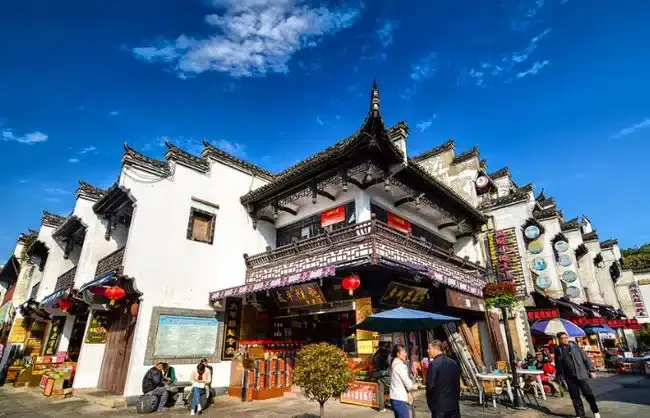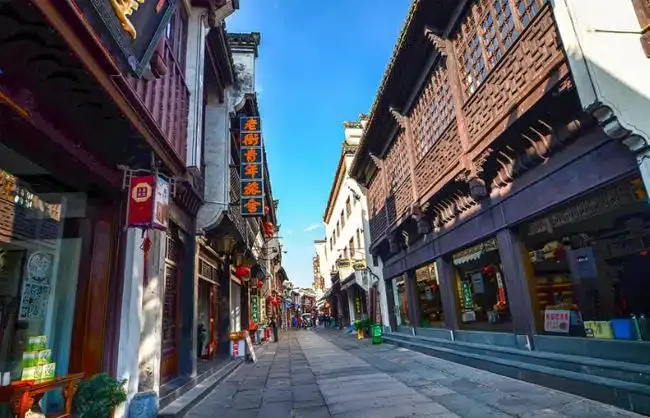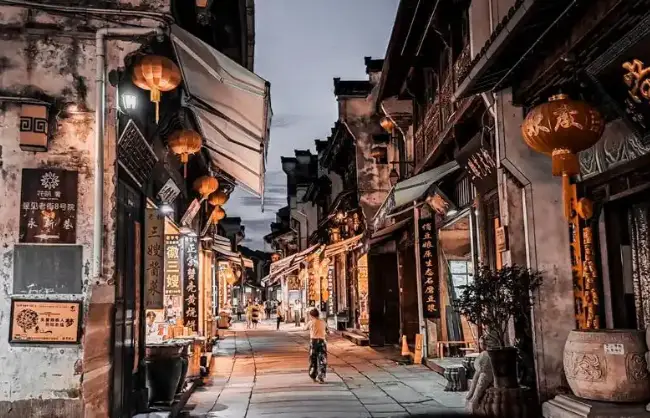Tunxi Ancient street, located in the center of Tunxi district, Huangshan city, is 1,272 meters in total length with 853 meters long of the essence section, and 5 to 8 meters in width. With the mountain in the north and a river in the south, it consists of 1 straight street, 3 bystreets and 18 alleys.
The whole street composed of over 300 hui-style buildings constructed in different ages, and it is distributed in the shape of a fish skeleton. In 2009, Tunxi ancient street, Guozijian street of Beijing and Pingjiang road of Suzhou were elected as the “Chinese historical and cultural street”. For a cultural experience during your Huangshan travel, visit the Tunxi Ancient Street and witness the well-preserved traditional Huizhou architecture.

Tunxi Ancient Street Facts
- Address:52-2, Southeast Direction, 50 Meters, Tunxi District, Huangshan City, Anhui Province, China
- Type:Ancient Street; Historic Site
- Opening Time: All day
- Best Seasons:All Seasons
- Recommended Visiting Time: about 1~3hours
- Tickets: Free
Why Visit Tunxi Ancient Street in Huangshan
Tunxi Ancient Street History
Tunxi Ancient Street is developed from a wharf located at the confluence of Xin’an river, Heng river and Shuaishui river. Since Ming dynasty, there have had related recordation about Tunxi Street. The west end of the old street is the birthplace of Tunxi, which was called “Bajia zhai”. The formation and development of the old street was closely related to capital relocation to Hangzhou in the Song dynasty. Tunxi Ancient Street was also called “Song City”, because local people started to build a lot of architectures similar to the new capital after relocation.
During the period of the republic of China, Tunxi Ancient Street was named as Zhongshan main street. After the founding of new China, it was renamed as People road. And in 1985, it gained the current name — Tunxi Ancient Street. With its profound history and modern amenities, Tunxi Ancient Street offers incomparable experience in a Huangshan tour.
A Hub in Southern Anhui
With the springing up of the Huizhou merchants in Ming and Qing dynasties, Tunxi old street had become the important transportation hub of the waterway due to its advantageous location and famous trade market here. In the 1930s and 1940s, a large number of people moved into the city to avoid wars, which promoted the development of business here and made it become a significant commercial hub in Southern Anhui. It was also enjoyed the reputation of “small Shanghai” at that time because of its prosperity and bustling.
Since 1949, with the rapid expansion of the city scale and construction of numerous modern buildings, Tunxi has undergone tremendous changes. But Tunxi Ancient Street has been well protected, which allows the profound trade culture to be passed on from generation to generation.

The Art of Tunxi Ancient Sreet Architecture
The architecture of Tunxi Ancient Street still maintains the traditional style of Huizhou ancient architecture. Along the street, there are 280 shops, most of them are two-storey buildings. The first floor is the place for business, and the second floor is the place to live. The architectural complex of the ancient street inherits the traditional architectural style of Huizhou folk houses, and its layout and architectural form have distinctive architectural features of Anhui style. The buildings on the Tunxi Ancient Street, though destroyed several times by wars and fires, they retain the original structure and style such as small green tiles, white walls, matou walls after reconstructing.
A Street of Delicacy
Nowadays, Tunxi ancient street is also a famous snack street and commercial street. The block is paved with bluestoneroad and lined with Hui-style buildings on both sides, and various kinds of Huizhou specialties sold in shops. Visiting it during the day time, you could immerse yourself in the beauty of Hui style architectures, and appreciate all kinds of exquisite carvings,such as brick carving, wood carving and stone carving. Visiting popular attractions like Tunxi museum, Wancui tower is a good choice as well. During the night time, there is more lively and prosperous than the day time. The string of red lanterns and busy shops on the street make it a great place to shoot the night scene.
What to Explore in Tunxi Ancient Sreet
Appreciating the Abundant Souvenirs
Tunxi Ancient Street is renowned for its wide array of souvenirs, including the Four Treasures of the Study, gold and stone calligraphy and paintings, Huizhou’s Four Carvings, and local specialties. You can also find stone teapots, batik, toys, and antiques. Most of the antiques are collected from the surrounding rural areas, as there were many merchants and officials in ancient Huizhou. The Ancient Street has become a hub for today’s tourist goods, offering the most comprehensive selection and the best prices for souvenirs in Huangshan City. If have the chance to go to Tunxi during a Huangshan tour, be sure to check out the Tunxi Ancient Street.
Exploring the Tunxi Museum
There are two museums on the Tunxi Ancient Street. One is the Tunxi Museum (state-owned), where the first floor mainly displays Ming and Qing dynasty furniture. The exhibits include floral beds (wedding beds), side tables, desks, armchairs, and arhat beds. Traditional Huizhou beds are enclosed with wooden panels at the top, back, and head, and the front of the bed is intricately carved with many exquisite patterns. The second floor exhibits ancient calligraphy and paintings, as well as porcelain, including a painting from the Qing Dynasty Qianlong period.
The other museum is the Wan Cui Lou, a private museum of ancient architecture that locals take great pride in. It is the first private museum in China built in the style of ancient architecture. Constructed in 1996, the four-story building features exquisite stone, brick, and wood carvings from the Ming and Qing dynasties, reassembled in the Huizhou architectural style.
Visiting Cheng Families’ Houses
The Cheng Families’ Houses are exemplary works of Ming Dynasty residential architecture and are designated as National Key Cultural Relics Protection Units. Located at No. 6, No. 7, and No. 28 in the eastern alley of Bishu Street, Tunxi District, Huangshan City, these three ancient buildings were constructed during the Chenghua period of the Ming Dynasty.
How to get to the Tunxi Ancient Street
Visitors can take Huangshan city Bus No.3, 5, 11, 12 or 15, and get off at Yuzhong Huyuan Station, then walk to the Tunxi Ancient Street.

Nearby Attractions
- Yellow Mountain: Yellow Mountain, anciently known as “the Capital of the Heavenly Emperor,” was considered the abode of deities and immortals.
- Mukeng Bamboo Forest: Mukeng Bamboo Forest is located in the mountains beside Hongcun, covered with vast bamboo forests that stretches for tens of square miles.
- Xidi Ancient Village: A village with a history of 950 years. The entire village is boat-shaped, surrounded by mountains on all sides.









